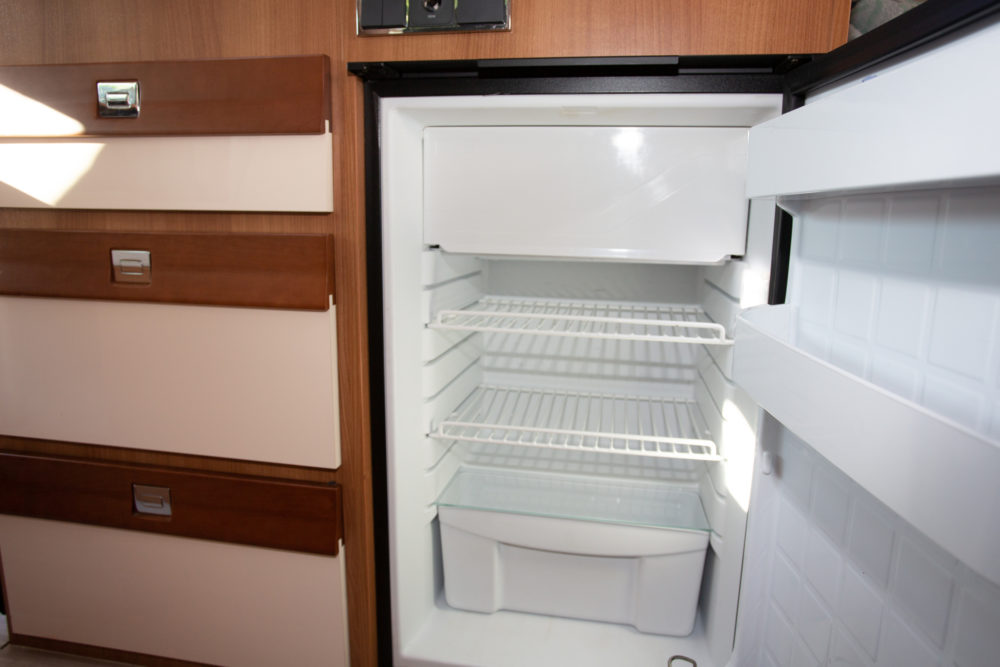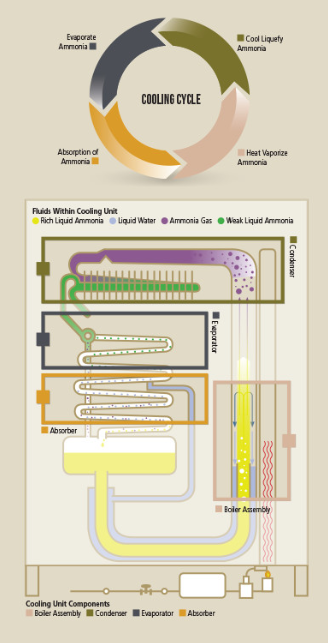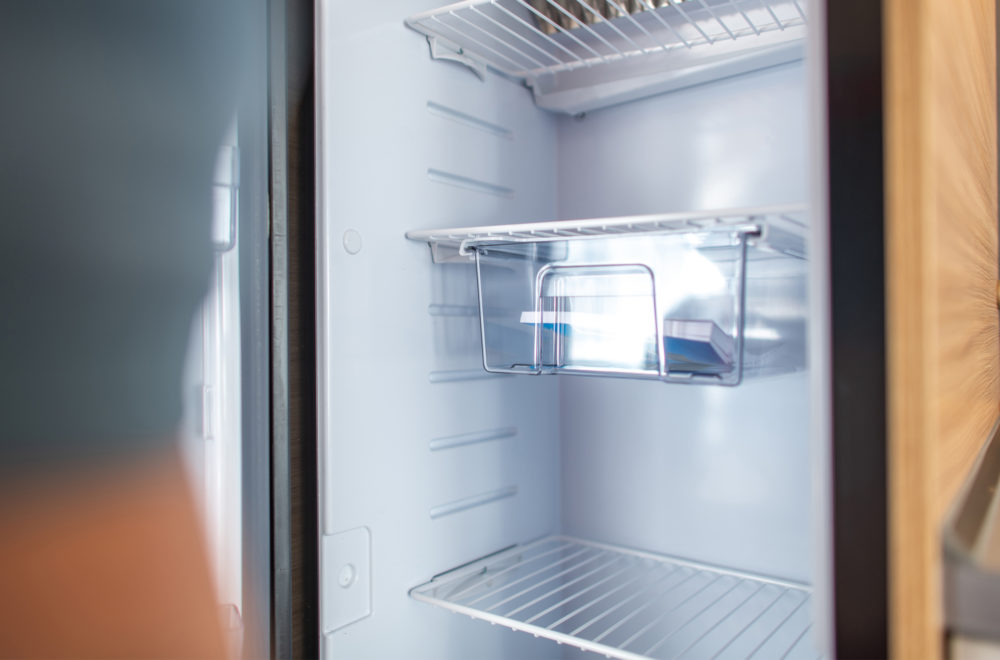How Does A Refrigerator Work In An RV?
How Is An RV Refrigerator Different From A Residential Refrigerator?
The RV refrigerator and the residential refrigerator are each designed differently, and therefore function differently because they are each designed for a different purpose and a way of use.

Contents
The RV refrigerator is built to run on either electricity or propane so that one can have a working refrigerator even when off-grid and without access to electricity. The RV refrigerators do ok when it comes to RV travel, with the vibration during travel.
However, they are a bit finicky with regard to performance, especially when not level or maintained properly.
There are RV refrigerators that run on 12V or 120V or propane, or others that run on 12V only.
“An RV refrigerator works by absorption and a chemical reaction between ammonia, water, and hydrogen. The ammonia is heated then goes through an evaporation and condensation process which causes the cooling effect of the fridge. The ammonia is heated either by a propane flame or electric element.” (Source: lifeonroute.com.)

The main working components of the RV refrigerator are the thermistor, thermostat, the fan, as well as the main control board. The propane RV has heating elements that heat up the Freon, which cools down the unit.
The thermistor is located in the condensing blade unit and uses resistance to communicate to the thermostat the level of satisfied temperature (usually 38-42F).
The thermostat controls the inside temperature of the fridge and freezer compartments.
The fan circulates the air, displaces the heat and prevents the condensing blades from freezing over, keeping the condensate lower.
The residential refrigerator, on the other hand, is designed to be stationary and to run on 120V electricity only. “A residential-style refrigerator uses a compressor to keep contents cold and uses AC power to run. That means the same is true of an RV residential refrigerator. Unlike other types of RV refrigerators that use propane either full-time or part-time, a residential fridge in an RV uses AC power all the time.” (Source: www.thervgeeks.com.)
The average lifespan of a well-maintained RV unit is approximately 14 years, with a 10-18 years span. Of course, this depends largely on use, environment in which the RV is most of the time and the brand.
The average lifespan of a well-maintained residential unit is 15-20 years. This assumes that one takes good care of the unit, including regular de-icing and not leaving the fridge open for extended amounts of time.
What Are The Types of RV Refrigerators?
Compression refrigerators typically use an HCFC or HFC, while absorption refrigerators typically use ammonia or water and need at least a second fluid able to absorb the coolant, the absorbent, respectively water (for ammonia) or brine (for water).
The main difference between the two systems is the way the refrigerant is changed from a gas back into a liquid so that the cycle can repeat. An absorption refrigerator changes the gas back into a liquid using a method that needs only heat, and has no moving parts other than the refrigerant itself.
(Source: www.researchgate.net)

The refrigerator compressor should be around 275F, that’s how it works.
“Compressor refrigerators are able to chill to lower temperatures and cool more consistently than absorption refrigerators regardless of the outside ambient temperature, due to the more powerful compressor motor. Most compressor refrigerators can double as freezers because of the powerful compressor motor.” (Source: www.lichtsinn.com)
As a rule of thumb, an absorption refrigerator will cool the: Freezer compartment to 40 degrees below ambient temperature. Fridge compartment to 25-30 degrees below ambient temperature.
Winnebago does a great comparison video on compression vs absorption refrigerators: www.lichtsinn.com
Basically, compression refrigerators are able to chill down and cool more consistently, while absorption refrigerators must maintain a level terrain to function on LP. The compression refrigerator does not require any external venting while the absorption refrigerator does (and largely depends on the external temperature).
Compressor refrigerators do make audible noise (compressor and fan running, many consider it white noise) and drive up the initial starting investment cost.
Different Power Sources For RV Refrigerators
In the RV refrigeration industry you have mainly three different choices:
- A 12V only RV refrigerator
- A 12V/120V/propane refrigerator
- A residential 120V only refrigerator.
The pros of having a dual-source RV refrigerator is that one can use the refrigerator off-grid without a generator and switch to propane. With a residential fridge, you must have shore power or a generator to keep the unit running.
How do you install a residential RV refrigerator?
Below is a video on how dealerships do this upgrade:
Step 1: If you want to swap out your RV refrigerator for a residential refrigerator, you will need to have an inverter on board. If you don’t have one, it will have to be installed first.
Step 2: Make sure your new fridge will fit top-to-bottom and side-by-side, as well as the depth to keep the space usable.
Step 3: Turn off the propane and turn on the heat to drain the lines of propane.
Step 4: Open the back of the RV refrigerator: the propane line, the 12V line and the 110V line are there. If you do not feel comfortable handing these, hire a professional.
Step 5: Disconnect and cap off the propane line.
Step 6: Cap off the 12 V line and keep the 11V line that was used for the icemaker-that will be the new refrigerator power supply.
Step 7: You will need a forklift and several people to take the refrigerator out. Sometimes, one has to even take out the slide-out. Sometimes you have to take out a window and remove the fridge doors to get the entire unit out.
Step 8: Bring in the new refrigerator. Inspect the capped off propane line: if it is in a good shape and you want to keep it in place in case you ever switch back to a propane refrigerator, simply keep it capped off. If the hose appears damaged in any way, remove it and cap off at the wall.
Step 9: Turn on the inverter and determine/confirm your power source.
Step 10: Install the new wooden platform, coat it with waterproof coating and brace the fridge onto the refrigerator. Use a jack to lift the fridge.
Step 11: Reseal and reinstall the window, if needed.
Step 12: Plug in the unit for 24 hours to test the unit.
How do you install a propane RV refrigerator?
This process is much like the one listed above, with the exception that you must have a designated propane line and the 12V wiring in place. This is something that you most likely will hire out because a mistake can be costly and even dangerous.
Do RV Refrigerators Use A Lot Of Electricity?
The RV refrigerator draws a lot of electricity when in use. The RV refrigerator draws about as much electricity as an air conditioner. As one camper shares: “[t]he small RV refrigerator ended up using about 5 kWh of power per day. Our entire battery bank is about 24 kWh. This means that nearly every day about 20% to 25% of all our usable battery power would need to go to powering the refrigerator.” (Source: www.beginningfromthismorning.com.)
The residential refrigerator in the RV will cost about $154/year, on average.
Many agree that the RV refrigerator runs better on electricity, as it tends to perform better and keep the temperature more stable.
When it comes to running your refrigerator on propane, the numbers vary greatly, but on average, a 20-gal tank can get used up when the refrigerator runs continuously for 280 hours or 11 days (along with other appliances).
There is an RV refrigerator propane use calculator for anyone who would like to see their custom numbers: camperfaqs.com.

How To Convert Your RV Refrigerator Power Source
- For example, how do you convert from electric to propane?
- What is the cheapest or most efficient type of RV refrigerator power source?
Two-Way vs. Three-Way RV Refrigerators
Who Makes The Best RV Refrigerators?
The most used RV refrigerator brands are Dometic and Norcold. The top RV refrigerators in 2022 are:
- Dometic DMC4101 RV Refrigerator
- Everchill Mini 12 Volt RV Refrigerator
- Norcold Polar-Series 10 cu. Ft Compressor Fridge
- Dometic RM 1350S
(Source: www.thecrazyoutdoormama.com)
The Dometic brand is known for being the global market leader for mobile living solutions and has been consistently being ranked high in quality and innovation.
The Norcold brand is known for being “the dinosaur” in the RV refrigeration industry: the company has been around since 1959 and is located in Sidney, Ohio.
Some of the features of a top-quality refrigerator are:
- Ability to function properly (stable temperature)
- Longevity
- High-quality internal electronic components.
An RV refrigerator is a costly item in the RV: the average cost of an RV refrigerator is about $2,000, with a cost of anywhere between $1,000 and $3,000, depending on model and size of the unit.
Tips To Make Your RV Refrigerator Last Longer
There are several things you can do to extend the life of your RV refrigerator:
Do’s:
- Make sure the outside vents are not plugged or obstructed.
- Keep your RV unit level.
- Pre-cool the refrigerator prior to travel and store ice packs or pre-cooled food in it to help the unit bring down the temperature.
- Install mini-fans to move the air, helping the RV refrigerator work more efficiently.
- De-thaw regularly. Do not use an air dryer to de-ice the walls.
Don’ts:
- Do not overpack the fridge. Do not place items near the fridge walls.
- Do not leave the doors open for an extended amount of time. For every 10 seconds of open fridge doors, it takes one hour to have the refrigerator return to its set temperature. This is very hard on the unit.
How to properly maintain your RV refrigerator:
- When not in use, shut off the unit, empty it, wipe down with a wet cloth and prop open the doors to allow the unit to dry.
- De-ice when you start having an ice wall build-up in the freezer.
- Replace the door gasket seal.
- Install a muffin fan on the condenser coil.
- Park level and keep your refrigerator out of direct sunlight.
FAQs
Will RV refrigerators work if not level?
No, the RV refrigerator will not work properly if not level. At minimum, you will have heavy ice wall buildup. This can lead to bigger issues, even expensive repairs, if done for an extended amount of time.
The cooling fluids flow through the ducts using gravity. If the fridge is not arranged properly, it can overheat and be damaged! Some compressors only carry out their task when they are located in a perfectly vertical position.
Do RV refrigerators need to be vented?
Yes. “Looking into RV refrigerator vent installation will show you that two vents are necessary — one for intake and one for exhaust. The intake vent must be properly placed on the outside of the vehicle or home to also allow access to the burner area if any work or repairs need to be done.” (Source: www.hunker.com.)
Is there a reset button on a camper refrigerator?
Both Norcold and Dometic have a reset switch.
Can you recharge an absorption fridge?
They are sealed and can’t be refilled. However, the Absorption refrigerator’s cooling unit can get a replacement in case of any harmful leakage. I would recommend you get a professional diagnosis before replacing your cooling unit. It might be difficult finding the correct cooling unit for your fridge. (Source: crowsurvival.com)
Can you leave your RV fridge on propane while driving?
Yes, you can leave your RV refrigerator on propane while driving (and there are many RVers who do that). However, the RV manufacturers, the refrigerator manufacturers, as well as the RV dealers will all advise against this due to the risk of fire (and the liability associated with it if they were not to warn the end user). That being said, many long-time full-timers share on RV forums that they have been using the propane on the fridge during long stretches of traveling without issues.
This is a risk that each individual must assess for themselves: if they are ok with the risk, then that is their issue. The insurance will not cover any damage that occurs in these situations, however.
Most of the time, the fridge should keep the temperature cold for a 5-hour drive, if pre-cooled 24-48 hrs prior to the trip. One can also add ice packs to assist the fridge to stay cold.
Can I replace my RV refrigerator with a standard refrigerator?
Yes, you can; however, it will require some electrical rewiring. You should also consider the repercussions of that modification: while you might gain space and get a better performance, the commercial refrigerator runs on 120V and thus, is not a good fit for those who love off-grid RVing (when you can switch the RV refrigerator to run on propane).
